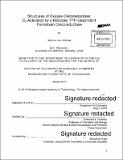| dc.contributor.advisor | Catherine L. Drennan. | en_US |
| dc.contributor.author | Gibson, Marcus Ian | en_US |
| dc.contributor.other | Massachusetts Institute of Technology. Department of Chemistry. | en_US |
| dc.date.accessioned | 2015-09-17T19:14:17Z | |
| dc.date.available | 2015-09-17T19:14:17Z | |
| dc.date.copyright | 2015 | en_US |
| dc.date.issued | 2015 | en_US |
| dc.identifier.uri | http://hdl.handle.net/1721.1/98818 | |
| dc.description | Thesis: Ph. D. in Inorganic Chemistry, Massachusetts Institute of Technology, Department of Chemistry, 2015. | en_US |
| dc.description | Vita. Cataloged from PDF version of thesis. | en_US |
| dc.description | Includes bibliographical references. | en_US |
| dc.description.abstract | Oxalic acid is a two-carbon diprotic acid that is toxic to humans. In large doses, it can cause death by poisoning, and in smaller doses over time it can lead to chronic renal disease, such as the formation of kidney stones, acute renal failure, as well as other complications such as crystalline arthritis. Current strategies to mitigate oxalate toxicity focus on diet management, though recent therapeutic studies have begun to focus on both probiotic as well as enzymatic treatments for the prevention of oxalate-related illnesses. The acetogenic bacterium Moorella thermoacetica has been known for some time to metabolize oxalate, though the unique enzyme responsible was only recently discovered. M thermoacetica employs an oxalate oxidoreductase (OOR) to oxidize oxalate to two molecules of C0 2, generating two low-potential electrons. OOR uses a thiamine pyrophosphate (TPP) cofactor to cleave the C-C bond, and three [4Fe-4S] clusters to capture and transfer the electrons produced. Both of these products from oxalate degradation, CO 2 and the low-potential electrons, allow M thermoacetica to grow via the Wood-Ljungdahl pathway for acetogenesis (also known as the reductive acetyl-CoA pathway). OOR is a member of the larger superfamily of 2-oxoacid:ferredoxin oxidoreductase (OFOR) enzymes. OFORs are found in microorganisms across all domains of life, and are responsible for performing a number of essential metabolic reactions, including the conversion of pyruvate to acetyl-CoA. Though, most OFORs require coenzyme A as a co-substrate, OOR is the exception to this rule, as it is capable of metabolizing oxalate without the aid of CoA. To aid in understanding this newly discovered enzyme, we have determined three crystal structures of OOR. These structures have allowed us to visualize the resting state as well as two reaction intermediates: an oxalate-TPP adduct and a C0 2-TPP adduct. Additionally, these structures have revealed dramatic protein conformational changes in the active site that are likely to facilitate catalysis. As OOR is only the second OFOR to be structurally characterized, these structures have provided a wealth of information about the larger OFOR superfamily as well as about this novel mechanism of oxalate metabolism. | en_US |
| dc.description.statementofresponsibility | by Marcus Ian Gibson. | en_US |
| dc.format.extent | 138 pages | en_US |
| dc.language.iso | eng | en_US |
| dc.publisher | Massachusetts Institute of Technology | en_US |
| dc.rights | M.I.T. theses are protected by copyright. They may be viewed from this source for any purpose, but reproduction or distribution in any format is prohibited without written permission. See provided URL for inquiries about permission. | en_US |
| dc.rights.uri | http://dspace.mit.edu/handle/1721.1/7582 | en_US |
| dc.subject | Chemistry. | en_US |
| dc.title | Structures of oxalate oxidoreductase : C₂ activation by a microbial TPP-dependent ferredoxin oxidoreductase | en_US |
| dc.type | Thesis | en_US |
| dc.description.degree | Ph. D. in Inorganic Chemistry | en_US |
| dc.contributor.department | Massachusetts Institute of Technology. Department of Chemistry | |
| dc.identifier.oclc | 921148357 | en_US |
